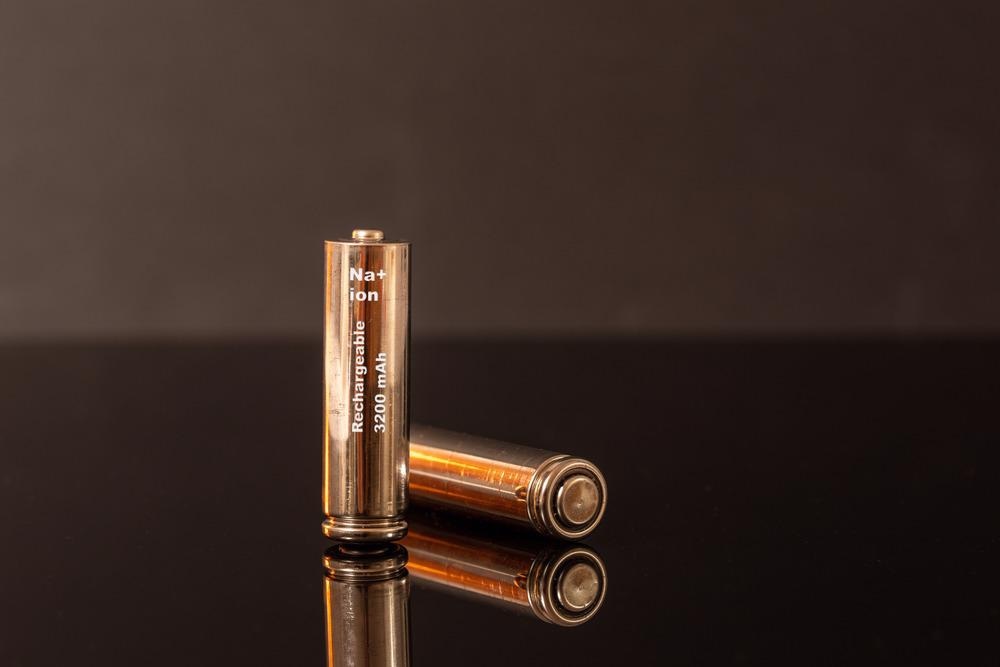In a recent study published in the journal ACS Materials Letters, researchers developed a new physical structure with high areal capacity for the electrodes of high-energy-density sodium-ion batteries (SIBs). The purposed electrode is a vertically aligned self-standing foam with an ultrathick (1500 μm) wall made up of carbon framework and embedded 1T-MoS2 nanosheets.

Study: Confined Iterative Self-Assembly of Ultrathick Freestanding Electrodes with Vertically Aligned Channels for High Areal Capacity Sodium-Ion Batteries. Image Credit: gcarnero/Shutterstock.com
The foam electrode consisting of a mesh of vertical channels provided a high areal mass of 20.74 mg cm−2 without the need of any binder, current collector, or carbon additive. Further, a confined iterative self-assembly strategy was used to control the morphology and areal mass of the foam.
SIBs with High Areal Capacity
SIBs are a cheap and readily available alternative to lithium-ion batteries (LIBs); however, their low energy density limits their demand. The most common approach to increase the energy density of any metal-ion battery is finding new electrode materials with a high specific capacity, such as silicon, sulfide, carbon-based materials, and alloys.
However, the energy density of the electrode can also be increased by increasing the mass loading of active materials, which requires a better design of the physical structure of the electrode specific to its field of application. In the case of a conventional solid electrode, higher mass loading means higher impedance and increased volume change during cycling. Thus, most solid electrodes have a thickness of fewer than 100 μm.
Meanwhile, self-standing electrodes are themselves the composites of active materials, thus do not require separate binders, current collectors, or carbon additives to hold together up to very high thicknesses. Additionally, carbon frameworks can make the whole mass of the electrode active material for enhanced capacity. High areal mass means more mass of active materials per unit area, thus more energy density.
About the Study
In this study, researchers developed an electrode for SIBs with vertically aligned self-standing foam with an ultrathick (1500 μm) wall made up of carbon framework and embedded 1T-MoS2 nanosheets. The vertical compartments of the foam were used as the sodium storage, whereas the high conducting 2D metallic 1T-MoS2 nanosheets facilitated a path for sodium-ion (Na+) diffusion. The carbon framework was the core structure of the electrode walls that provided high conductivity, improved mechanical stability, and adequate internal space to accommodate large volumetric changes during sodiation/desodiation.
More from AZoM: Nanosizing of LGPS to Enhance its Li-Ion Conductivity
Firstly, a vertically aligned microchannel-shaped mold was cooled on one side by using liquid nitrogen. After that, 1T-MoS2 and chitosan (CS) water solution was poured onto that mold which gradually started to solidify unidirectionally from the cold side. Moreover, a confined iterative self-assembly strategy was used to increase the height of vertical channels and reduce the corresponding width, which resulted in increased areal mass density in successive iterations.
Observations
SEM images showed that 1T-MoS2 had a fluffy ball-like shape with individual 1T-MoS2 nanosheets extending from the center to the periphery of the ball of 200 nm diameter. The FT-IR ID/IG ratio of MoS2@CSC (the last C corresponds to the carbon framework) was 0.93, indicating the formation of a high crystalline structure due to the reaction between MoS2 and CS. XPS spectra revealed the binding energies of Mo 3d3/2, Mo 3d5/2, S 2s, C 1s located at 231.7, 228.6, 226.0, and 284.8 eV, respectively. The Mo 3d3/2 and Mo 3d5/2 binding energies were attributed to 1T-MoS2 polymorphs.
The CV curves of the MoS2@CSC electrode showed two oxidation peaks at 1.70 and 0.40 V and three reductive peaks at 0.05, 0.25, and 0.75 V. Each reductive peak corresponds to the formation of solid electrolyte interphase, conversion of NaxMoS2 to Na2S and Mo, and Na+ insertion into electrodes. The confined iterative self-assembly strategy led to an areal mass of 12.61, 19.45, and 22.00 mg cm−2, and a corresponding areal capacity of 2.03, 4.45, and 4.72 mAh cm−2 for MoS2@CSC-I, MoS2@CSC-II, and MoS2@CSC-III, respectively.
Conclusions
In summary, the researchers of the study developed a vertically aligned self-standing foam electrode made up of a carbon framework embedded with 1T-MoS2 and CS on the wall. The vertical microchannels provided efficient electrolyte and ion diffusion paths, whereas the hollow compartments accommodated large volume change during cycling. More importantly, the high areal capacity contributed to high energy density. Hence, self-standing micro-channeled MoS2@CSC foam is a promising areal capacity tunable electrode for SIBs.
Disclaimer: The views expressed here are those of the author expressed in their private capacity and do not necessarily represent the views of AZoM.com Limited T/A AZoNetwork the owner and operator of this website. This disclaimer forms part of the Terms and conditions of use of this website.
Source:
Zhang, S., Feng, D., Xu, L., Du, J., Li, Bao, Wang, B., Confined Iterative Self-Assembly of Ultrathick Freestanding Electrodes with Vertically Aligned Channels for High Areal Capacity Sodium-Ion Batteries, ACS Materials Letters, 2022, 4, 432-439, https://pubs.acs.org/doi/10.1021/acsmaterialslett.1c00806